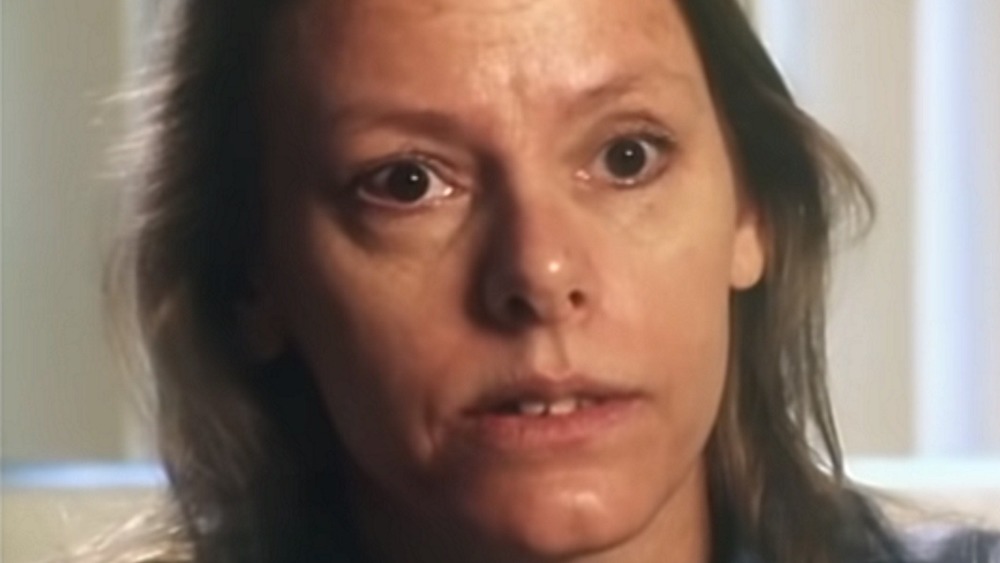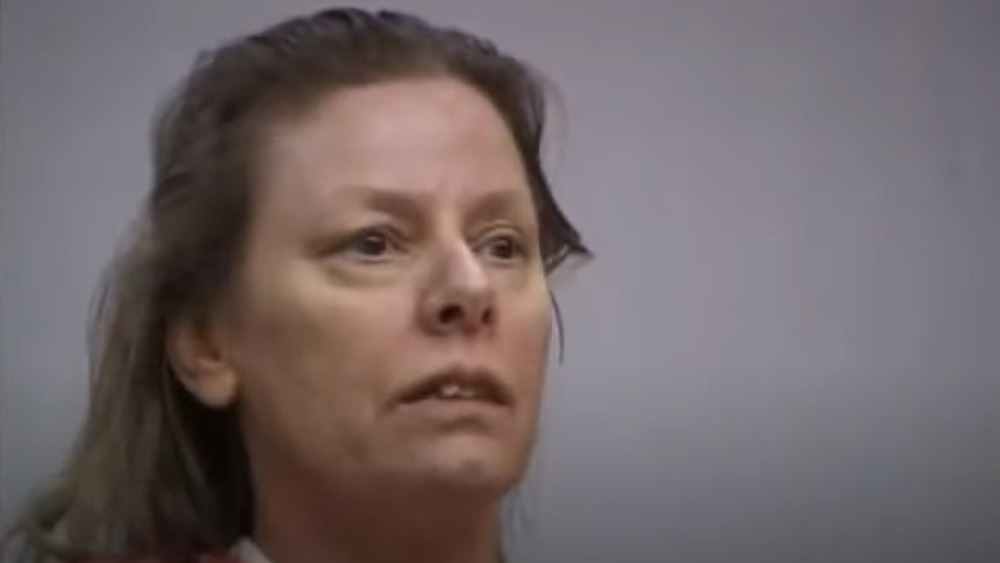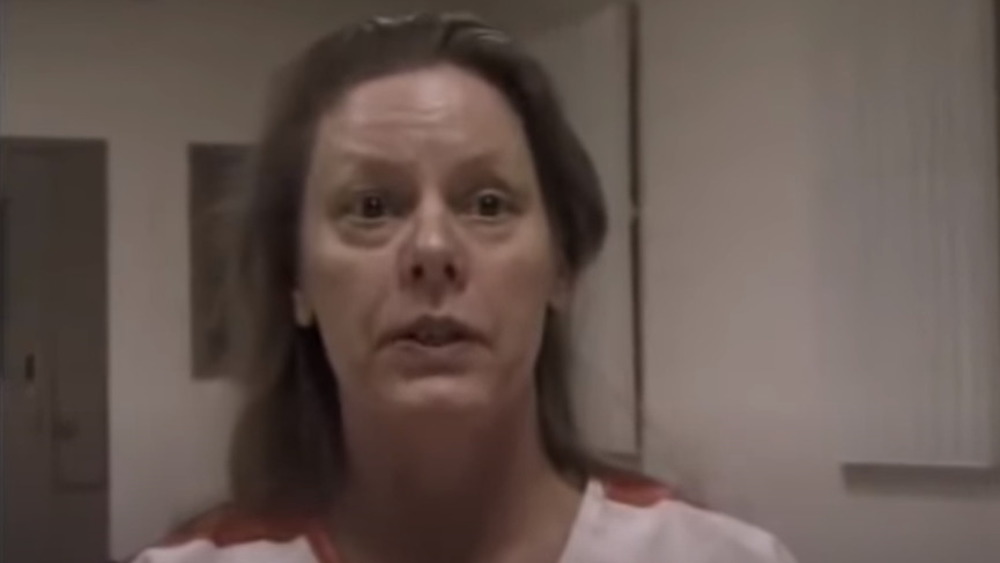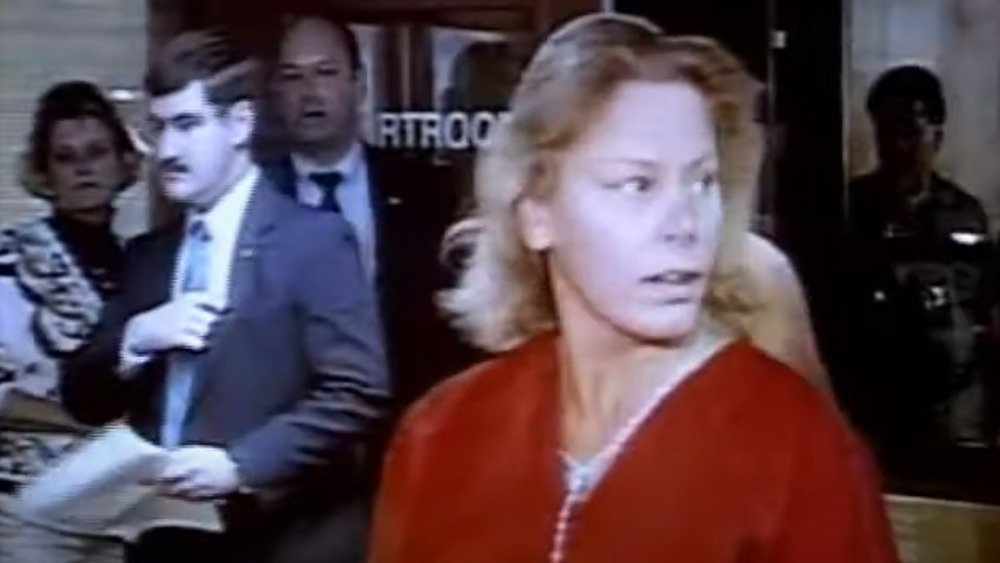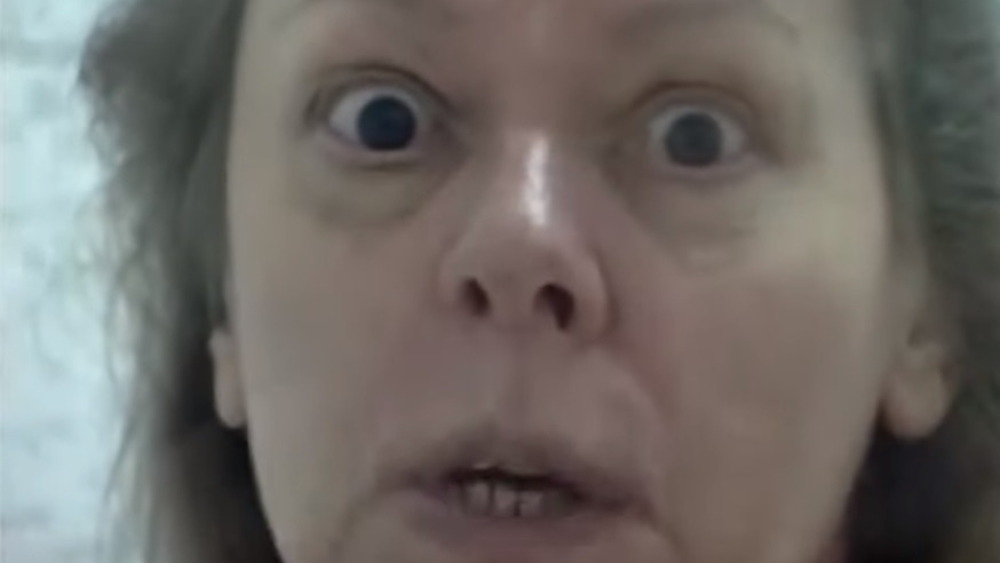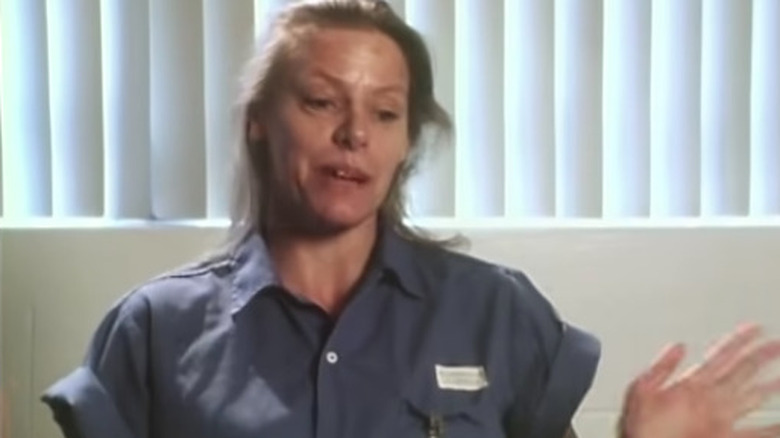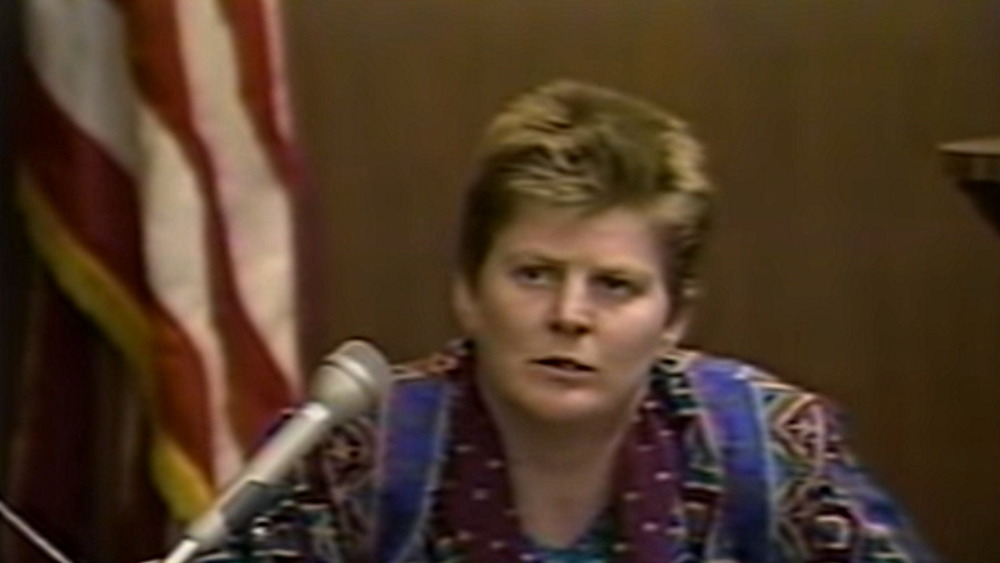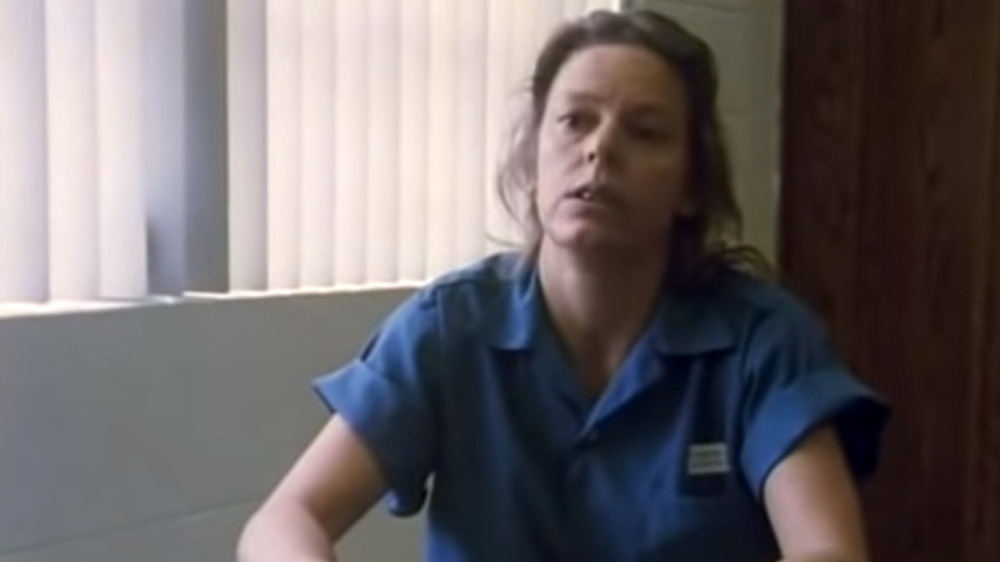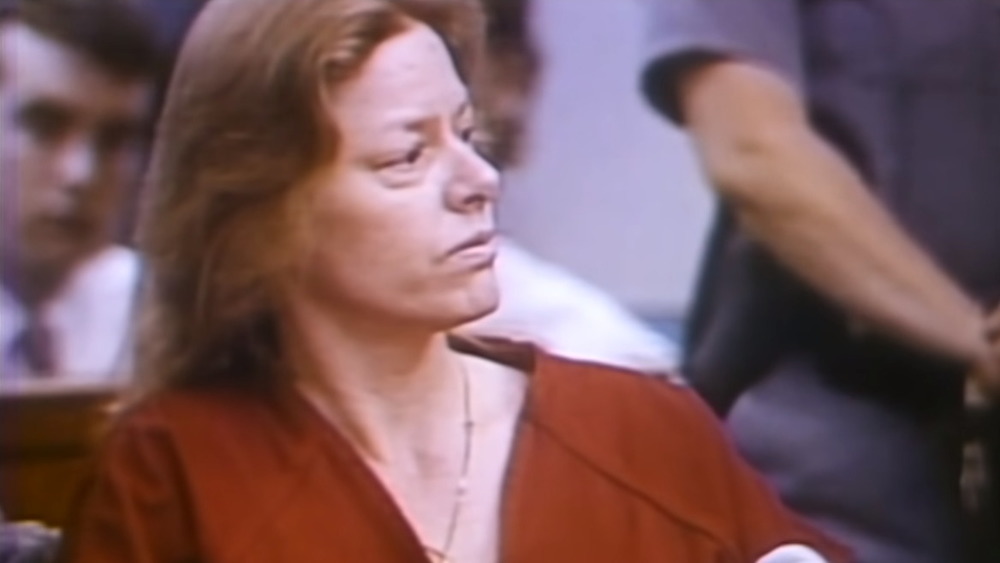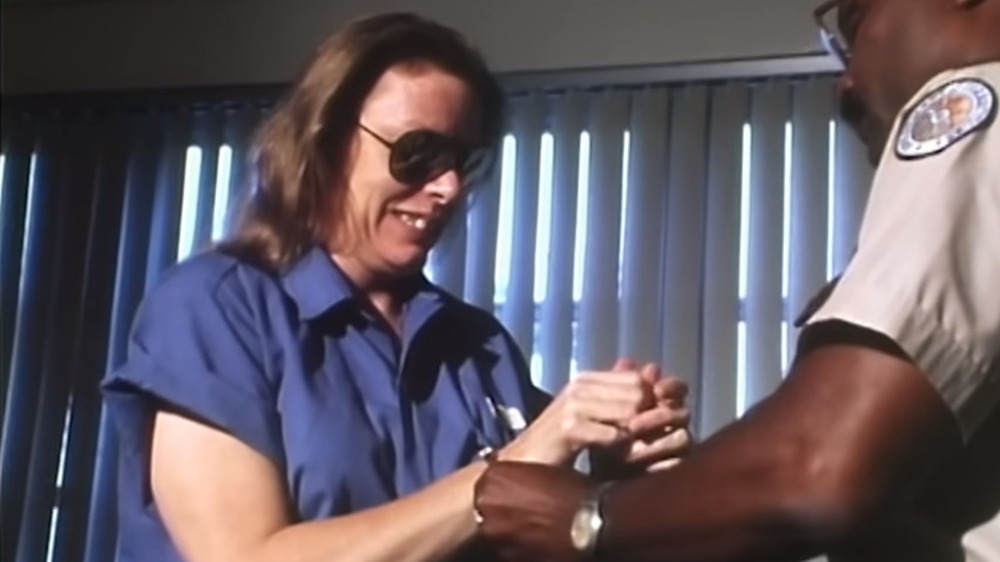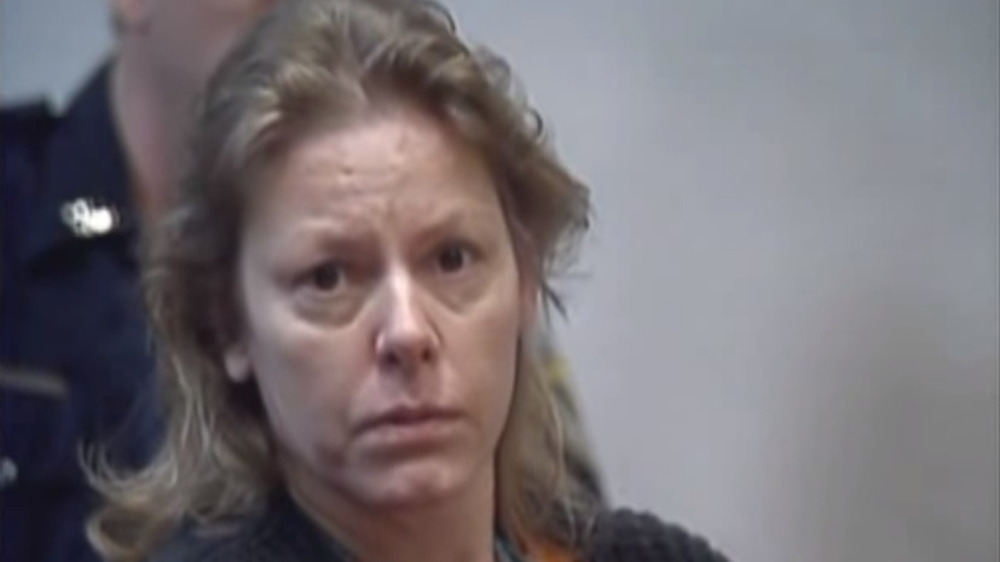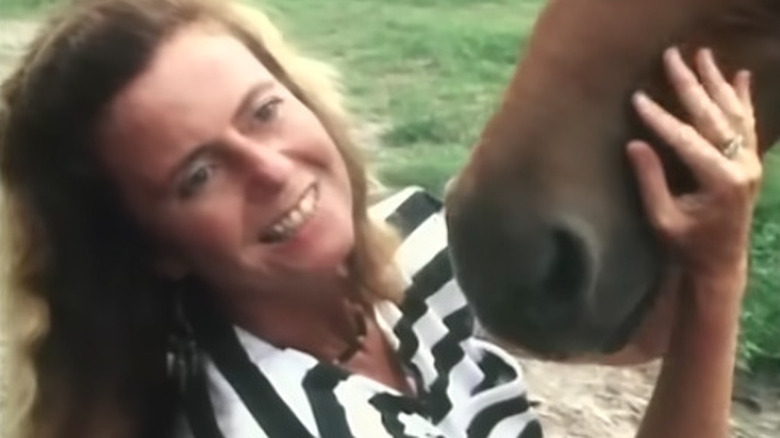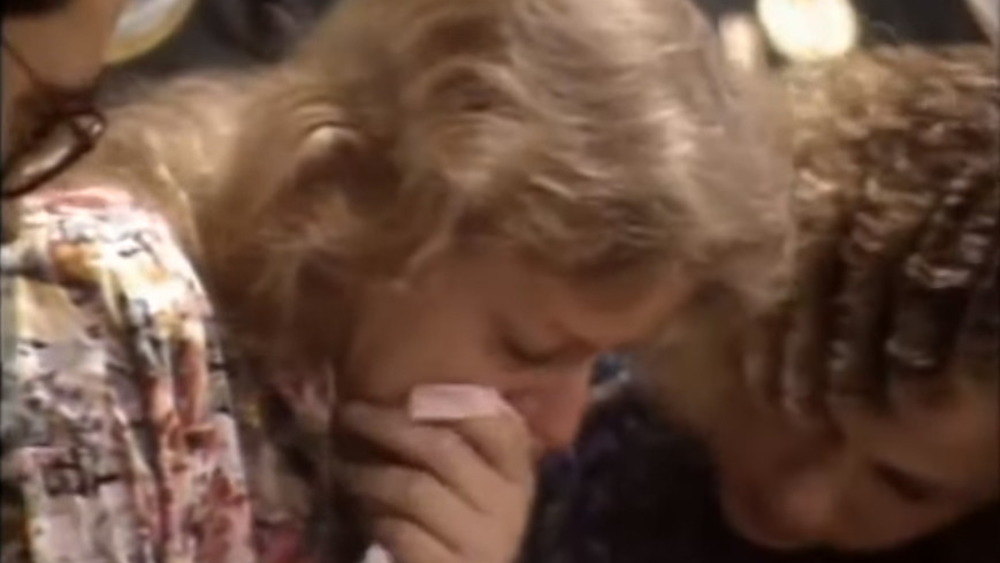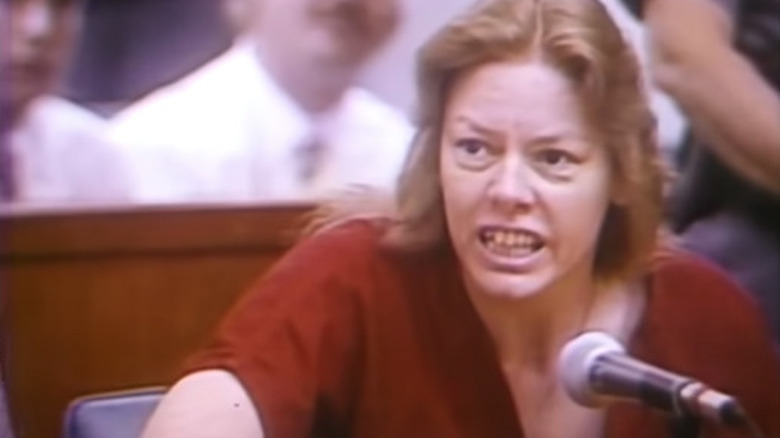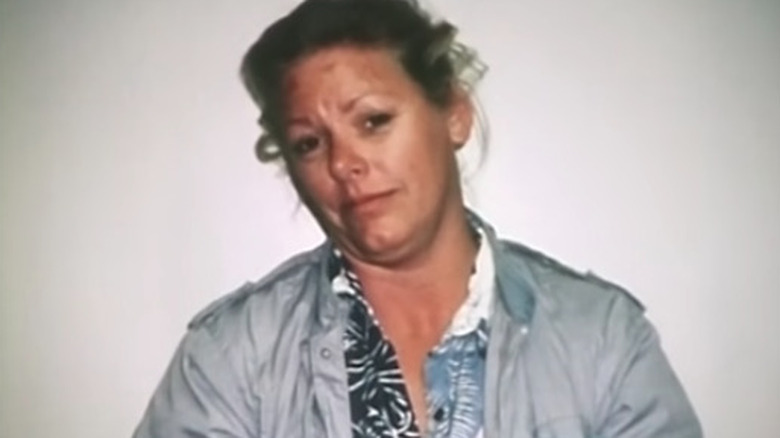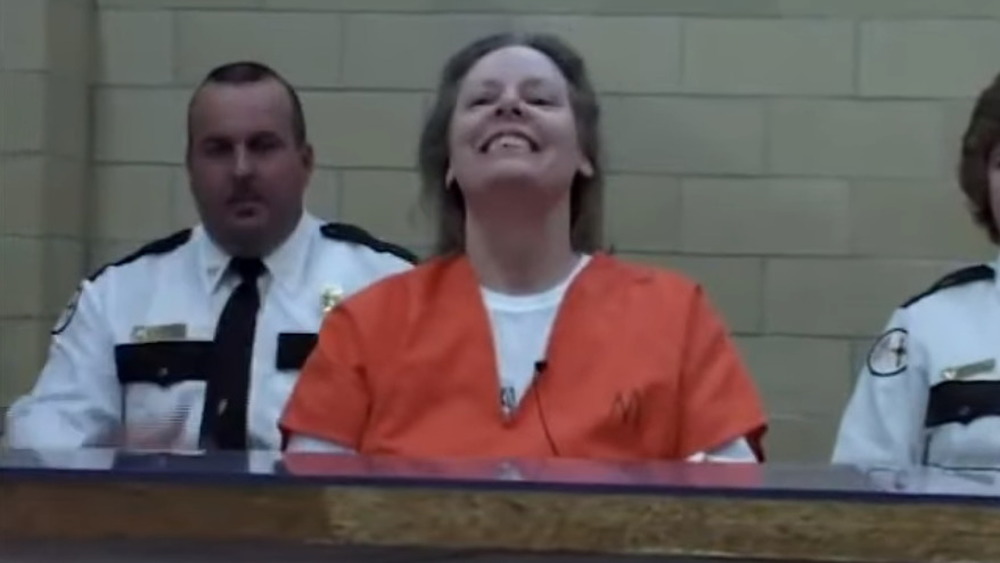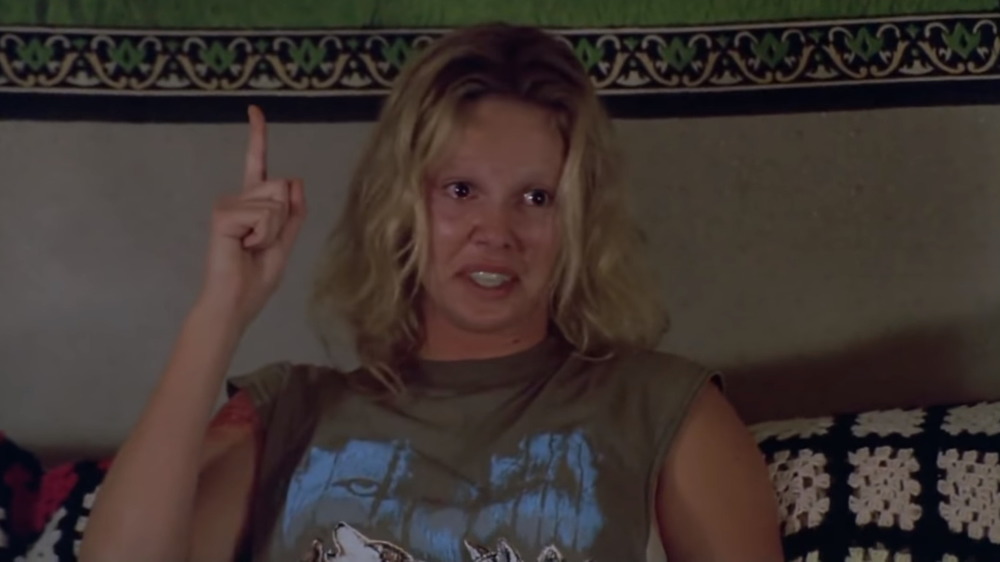The True Story Of Serial Killer Aileen Wuornos
In 1991, a 35-year-old illegal sex worker from Michigan shattered a long-held myth about serial murder when she confessed to killing seven men in Florida over the course of a year. For decades, the gruesome crimes of such repeat killers as Ted Bundy, John Wayne Gacy, and David Berkowitz seemed to establish a basic profile of the serial killer as white, often motivated by sexual dysfunction, and exclusively male. Aileen Carol Wuornos proved that serial murder is an equal-opportunity terror.
Labeled "America's first female serial killer" by a press motivated by sensationalism and exploitation, Wuornos was unique in the annals of crime. Famed FBI profiler Robert K. Ressler, the man credited with coining the term "serial killer" as well as establishing the patterns found in serial murder, described Wuornos as an anomaly in his extensive research. "Only one female has been arrested and accused as a serial killer — Aileen Wuornos in Florida," Ressler writes in his 1992 book "Whoever Fights Monsters." "Women do commit multiple murders, of course, but they tend to do so in a spree, and not sequentially as is the pattern with [men]."
One aspect of Wuornos' life, however, was all too typical among her male counterparts. Like Henry Lee Lucas, Charles Manson, and Richard Ramirez, she witnessed and experienced unimaginable abuse and violence in childhood. Ultimately, she slipped through every societal safety net and turned to crime out of desperation and to murder out of sheer anger. This is the horrifying, true story of Aileen Wuornos.
Aileen Wuornos' parents were young and troubled
Aileen Carol Wuornos, known as Lee to her friends, was born on February 29, 1956, in Rochester, Michigan (via Biography). As detailed in "Lethal Intent," by Sue Russell, Wuornos spent the first decade of her life believing that her grandparents, Lauri and Britta Wuornos, were her birth parents. In truth, Aileen and her brother Keith were the children of Lauri and Britta's daughter Diane. In 1953, Diane, then just 14, married 17-year-old Leo Pittman. Ten months later, their first child, a boy they named Keith, was born.
The marriage was marked with abuse and jealousy. Pittman, bent on controlling his young wife's life, forbade Diane from leaving home while he worked a variety of jobs, ranging from gardening to making chrome car bumpers. Pittman was also a petty thief who graduated to more serious crimes. Arrested for auto theft, Pittman was given the choice between jail time and enlisting in the Army. He left for basic training in 1955. With Pittman away, Diane, already pregnant with Aileen, filed for divorce.
When Aileen was two, Diane Wuornos abandoned her children, leaving them in the care of friends. Lauri and Britta Wuornos soon adopted Aileen and Keith and rarely spoke of Diane, considering her the family's shame. After several rebuffed attempts at rejoining her family, Diane Wuornos would remarry and have two more children.
Leo Pittman, who never had any contact with his daughter, returned to crime after his stint in the Army. A convicted sex offender, he committed suicide in prison.
Her childhood was horrific
According to author Sue Russell in "Lethal Intent," Lauri and Britta Wuornos exuded an appearance of decency and propriety in their suburban community of Troy, Michigan. The son of Finnish immigrants, auto-worker Lauri Wuornos was a firm and formal disciplinarian — a typical trait of 1950s fathers. His wife, Britta, was a loving mother to children Lori and Barry Wuornes, who would later romanticize their childhoods as idyllic.
However, life for Aileen and Keith Wuornes in their grandparents' home was anything but ideal. For Aileen in particular, it was a nightmare. Lauri Wuornos was a hard drinker who held his children's lives, especially those of his daughters, in an iron grip. As if to take out his anger with what he regarded as daughter Diane Wuornos' rebellion, Lauri made young Aileen the focus of his rage. Aileen suffered frequent beatings from her grandfather. As detailed in "On a Killing Day," by Dolores Kennedy, an infraction as small as forgetting to call Lauri "sir" resulted in violent lashings with a belt. Aileen would also claim and later deny that her grandfather sexually abused her.
An outcast among her peers, Aileen was trading sex for pocket change and cigarettes by age 12. At 14, Aileen Wuornos became pregnant. Although never positively identified, it has been alleged that the father was a friend of Lauri Wuornos. Expelled from the family home, Aileen gave birth in a home for unwed mothers in Detroit, and the child was put up for adoption.
She left home for the streets at 15
Following the birth of her child, 15-year-old Aileen Wuornos was allowed, if not accepted, back into her family's home. The pregnancy had embittered an already volatile teenager. "After that, she always said, 'All men are out to use women,'" Wuornos' sister Lori Wuornos Grody told the press at the time of her murder trial. "She said she hated men. She was very angry" (via "On a Killing Day," by Dolores Kennedy).
Resigned to life in a loveless home, Aileen Wuornos initially complied with her grandparents' rules, but lingering resentment soon drove her away again. Having returned to high school, Wuornos dropped out after a few months. Soon after, she wound up in a juvenile detention center. As detailed in "Lethal Intent," by Sue Russel, Grody suspected that her time in the reformatory would only make Aileen's behavior worse. While detained, Wuornos became adept at the game of pool. Later in life, Wuornos' skills with a cue would serve her well as a shrewd pool hustler.
After her stint in juvenile hall, Wuornos again returned to the Wuornos home, but after several attempts at running away, her grandfather forbade her to return. Homeless, she turned to illegal sex work and theft to support herself. Sleeping in the woods or in abandoned cars by night, she spent her days hitchhiking, drinking, and using drugs. "She was unloved, unwanted, and always in the way, and I think it gave her one hell of a chip on her shoulder," neighbor Jean Kear told author Sue Russell.
She turned to crime to survive
By the age of 18, Aileen Wuornos had graduated from truancy, petty theft, and shoplifting to burglary and more serious crimes with greater consequences. As detailed by Michael Reynolds in his 2004 book "Dead Ends," Wuornos' adult rap sheet outlined the life of a violent troublemaker on her way to becoming a career criminal.
In 1974, Wuornos was picked up by the police in Jefferson County, Colorado. Using the alias Sandra Beatrice Kretsch, Wuornos was charged with disorderly conduct, driving under the influence, and, in a bit of ominous foreshadowing, firing a .22-caliber pistol from the window of a moving vehicle. Two years later, she was arrested by Antrim County, Michigan, police for simple assault and disturbing the peace. At that time, she was also wanted for consuming alcohol in a vehicle and driving without a license.
On May 20, 1981, Aileen Wuornos was arrested for the armed robbery of a convenience store in Edgewater, Florida. That crime landed her in a Florida prison for a year. Nevertheless, Wuornos was back to her criminal ways by 1984, when she was arrested for passing forged checks. Arrests for grand theft auto, illegal weapons possession, weapons theft, and multiple instances of assault and battery marked Wuornos' police record throughout the 1980s. Wuornos would attempt to use a number of aliases to cover her tracks. Also known as Susan Blahovec, Lee Blahovec, and Cammie Greene, Wuornos even resorted to co-opting her sister Lori Grody's identity.
She was married to a wealthy 69-year-old man
After years of living as a transient and supporting herself as a teenager, Aileen Wuornos decided to marry rich and in 1976, she settled for a 69-year-old Floridian Lewis Fell, a wealthy retired businessman living near Daytona Beach. At the time, Wuornos had moved to Florida after a brush with the law and seemingly wanted to reinvent herself, according to Biography. But the marriage didn't last, as Wuornos couldn't escape her past, and their personalities couldn't be any more different. As Fell tended to his yacht club, Wuornos was getting into bar fights, per All That's Interesting. After an arrest, Fell had enough of her behavior.
But All That's Interesting reports that Fell had more reason to end their marriage. He alleged that Wuornos had beaten him physically with his cane, prompting him to file a restraining order against her. However, Wuornos once claimed the opposite had occurred. Per the Los Angeles Times, Wuornos said that Fell had beaten her with his cane. At any rate, an annulment soon followed, but Fell should consider himself lucky that it didn't escalate. This peculiar period in Wuornos's life was the subject of a prequel film to the 2003 biopic "Monster," called "Aileen Wuornos: American Boogeywoman," per ET Online.
Aileen Wuornos' tragic love affair with Tyria Moore
Aileen Wuornos had a string of failed and abusive relationships with men, and they had only served to reinforce her hate of the opposite sex. A marriage to a wealthy man three times her age ended after a month, writes Dolores Kennedy in "On a Killing Day." Wuornos claimed he beat her with a cane. Her life as a hitchhiking illegal sex worker had hardened her. To Wuornos, men were only good for the quick cash she needed to survive.
In the spring of 1986, Wuornos at last found the love she had spent a lifetime looking for when she met Tyria Jolene Moore at the Zodiac Bar in South Daytona. As documented in Michael Reynolds' "Dead Ends," Moore was a regular at the Zodiac. A native of Cadiz, Ohio, Moore had fled her small, conservative hometown in search of more gay-friendly environs in Florida at 26.
Wuornos and Moore hit it off immediately. From their first meeting, they were inseparable. With Moore's encouragement, Wuornos increased her illegal sex work to keep the pair in a rough but comparatively comfortable lifestyle of long-stay hotel rooms, booze, and drugs. "It was love beyond imaginable," Wuornos would state at her trial. "Earthly words cannot describe how I felt about Tyria." Nevertheless, at some point in their three-year relationship, the couple had exhausted any remaining spark of romance. By the end, they had become little more than hard-living traveling companions. It would be Moore's testimony in exchange for immunity from prosecution that would send Aileen Wuornos to the death chamber.
A question of self-defense: Her first victim
Aileen Wuornos killed for the first time on November 30, 1989. As reported by Tampa's NBC affiliate WFLA, Wuornos' first victim was Richard Mallory, the 51-year-old owner of a Palm Harbor, Florida, TV repair business. Mallory, who had been confined to a prison mental institution for ten years for a 1957 sexual assault in Maryland, picked Wuornos up along I-4 near Daytona Beach.
According to Sue Russell, author of "Lethal Intent," Wuornos and Mallory enjoyed some pleasant conversation and stopped for a six pack as they headed for Daytona Beach in Mallory's 1977 Cadillac. At some point, Wuornos admitted she was a sex worker and asked Mallory if he could help her make a little money. After discussing price, Mallory and Wuornos drove to a secluded, wooded area. Drawing a stolen, nine-shot .22-caliber pistol from her bag, Wuornos shot Mallory four times. After relieving Mallory of his ID and cash, she covered his lifeless body with a discarded piece of red carpet. Wuornos then drove Mallory's car home. She would tell her companion Tyria Moore that she had made a lot of money on the road and that "some guy" had loaned her his car.
The facts of what transpired between Wuornos and Mallory are unknown. Claiming that Mallory attempted to rape her, Wuornos stated that she fired in self-defense. Although she recanted and reaffirmed her self-defense plea several times, Mallory's past has left lingering doubts about the motive behind Wuornos' first murder.
A year of murder and misandry
Aileen Wuornos' next victim was David Spears, a 43-year-old construction worker (via Tampa Bay Times). Spears' body was discovered June 1, 1990, in Citrus County, Florida. Wuornos fired six shots from her .22-caliber pistol into his torso. According to "Dead Ends" author Michael Reynolds, Spears' autopsy report revealed that two shots had been fired into his back, indicating he was attempting to escape.
The next to die was 40-year-old highway worker and rodeo rider Charles Carskaddon. Carskaddon, described in "Lethal Intent" as the kind of man who wouldn't hesitate to help a stranded motorist, ran afoul of Wuornos on his way to pick up his fiancée. Wuornos shot him nine times in the chest and stomach. The decomposing body of 50-year-old salesman Troy Burress was discovered next — two .22 slugs buried in his chest.
On September 12, 1990, authorities discovered the bullet-riddled body of Charles "Dick" Humphreys, 56, in Marion County, Florida. A retired Air Force major and former Alabama police chief, Humphreys was working as a child abuse investigator at the time of his death. Retired merchant marine Peter Siems' body was never found. He disappeared after leaving his home near Jupiter, Florida, for New Jersey. Siems' 1988 Sunbird was found in June 1990. Witnesses placed Aileen Wuornos and Tyria Moore near the vehicle before its discovery.
Wuornos' last known victim was 62-year-old Walter Antonio. Shot four times in the back and the back of the head, the location of Antonio's wounds helped upend Wuornos' claims of self-defense.
Aileen Wuornos on the run
As detailed in "Dead Ends," by Michael Reynolds, Tyria Moore had grown uneasy with Aileen Wuornos' increasingly erratic behavior. The unusual stolen items Wuornos was bringing home for the couple to fence at area pawn shops unnerved her. Where were the electric razors, toolboxes, briefcases, guns, fishing gear, and watches coming from? Moore had her suspicions, but they were too horrible to contemplate. When they wrecked a stolen Pontiac Sunbird on a wooded road in Ocala, Florida, a panicked Wuornos had warned her to run because they were driving a "murdered man's car." It was only a matter of time before the law came down hard on Wuornos, and Moore wanted no part of it. She certainly wasn't going down as an accessory to murder. Finally, in November 1990, Moore told Wuornos she was leaving Florida to see her family in Ohio.
Meanwhile, the authorities were linking the seven murders. It was apparent that they were dealing with a serial killer or pair of serial killers, and, to their shock, they were likely women. Police sketches of the women dubbed the "angels of death" by the press appeared on local and national TV. Soon after, Volusia County police traced items belonging to murder victim Richard Mallory to a Central Florida pawn shop. The receipt for the stolen merchandise bore Wuornos' thumbprint. The hunt for the so-called "damsel of death" was on.
The confession of Aileen Wuornos
On January 9, 1991, Aileen Wuornos was arrested at a Port Orange biker bar called The Last Resort. Using an outstanding warrant for an earlier Colorado weapons charge, the police were forced to keep any mention of murder charges under wraps until they could find Tyria Moore. As detailed in "Dead Ends," investigators from Florida located Moore in Scranton, Pennsylvania. Assured that she was not under arrest, Moore explained that Wuornos had told her about killing Richard Mallory. At first, she didn't believe Wuornos, but the incident with the wrecked, stolen car further aroused her suspicions about Wuornos' activities. Claiming that she feared for her life, Moore neglected to alert the authorities.
Back in Florida, investigators convinced Tyria Moore to help them get a confession from Wuornos. Moore would write a letter to Wuornos requesting that she call her at a nearby motel. On January 14, 1991, Wuornos phoned Moore from jail. Investigators would be present to secretly record the calls and coach Moore. After 11 tense and tearful conversations over three days, Moore was able to convince Wuornos to confess to the killings.
At 10:14 a.m. on January 16, 1991, Aileen Wuornos, true to her word to Tyria Moore, met with Sgt. Bruce Munster and arresting officer Larry Horzepa in an interrogation room at the Marion County jail. Taking a seat across from the officers, Wuornos stated, "Well, I came here to confess to murder."
She was adopted when she was 35-years-old
It was 1991, and Aileen Wuornos was in the news for having allegedly murdered six men and was being held in a Florida jail. Her image was printed on newspapers, and somewhere in Levy County, Florida, God-fearing horse-breeder Arlene Pralle saw her photo and wanted to become her friend, details the Los Angeles Times. For Pralle, the allegations against Wuornos were beside the point; she believed that Wuornos needed an ally. Although only nine years older than Wuornos, Pralle decided to adopt the troubled woman.
Like Wuornos, Pralle had been adopted. But Pralle's act of kindness was mostly motivated by faith. She informed Wuornos that Jesus had spoken to her, motivating her to form the connection, as per the Tampa Bay Times. However, there were questions about Pralle's sincerity with claims she was out for the money, especially since Hollywood had come calling with offers for rights to Wuornos' story, even by Wuornos herself later (via the Orlando Sentinel). But due to a "Son of Sam" law at the time that prohibited felons from profiting off their stories, there was no money to be made, and the adoption itself was conditional on Pralle's agreement to not exploit Wuornos for money. Pralle was soon the loyal mother Wuornos never had, racking up $4,000 in phone bills for constantly ringing her up and even visiting her in prison every week.
Her trial and sentencing
Throughout her trial, Aileen Wuornos declared that each murder was an act of self-defense (via Justia). Maintaining that the victims had solicited her for sex and then attempted to rape her, Wuornos claimed she shot her victims to preserve her life. The case, as presented by her defense attorneys, painted Wuornos as a troubled woman with borderline personality disorder and an IQ of 81. Despite their best efforts, the defense was unable to use Wuornos' mental state and capacity to save her from the death sentence. The prosecution constructed a portrait of a calculating, man-hating killer who, under the guise of being distressed and stranded, lured seven innocent men to their deaths.
As documented in Nick Broomfield's "Aileen Wuornos: The Selling of a Serial Killer," Wuornos' courtroom behavior and erratic, conspiratorial thinking helped sabotage her defense. Despite pleading guilty to three of the crimes and no contest to three others, a tactic that she may have assumed would save her from the death chamber, Wuornos received a total of six death sentences.
Her adopted brother didn't back her child abuse claims
Aileen Wuornos had two brothers, Keith and Barry Wuornos, and she had troublesome relationships with both of them. Keith was her biological brother, son of Diane Wuornos, and like Aileen, he was adopted by their grandparents once their parents were out of the picture, details Sue Russell's "Lethal Intent." Aileen and Keith had a special bond in their new home since their grandfather, Lauri Wuornos, was tougher on both of them than on his own biological children, Lori and Barry Wuornos. The siblings became natural allies, both unafraid to stand up to Lauri and his strict parenting and often ran away from home together. But a darker truth connected the brother and sister; they had an incestuous but consensual relationship together. Aileen once told a friend that she had lost her virginity to Keith, who wanted experience before embarking on relationships with other girls. Aileen gladly obliged. Keith died at a young age due to cancer, and Aileen inherited a $10,000 insurance policy.
As for Barry Wuornos, he was technically Aileen's uncle, 12 years older than her, and was less of a friend. Once Aileen was arrested for murder, he threw water on her defense narrative, which claimed she suffered abuse at the hands of her adopted father. Barry testified and said their family was a typical one and although Laurie was strict, he was kind.
She was diagnosed as a psychopath
Before Aileen Wuornos died, she was analyzed in prison by a psychologist, Wade Myers. He administered a psychopathy test, according to his later case report, "The Role of Psychopathy and Sexuality in a Female Serial Killer." When it comes to the most cold-blooded female serial killer in history, the results answered some questions and filled in some holes. The Hare Psychopathy Checklist grades subjects numerically on 20 different behavior traits, including lack of remorse and antisocial behavior, details Psychology Today. The highest a person could score is 40, while the minimum score needed for a psychopathy designation could either be 25 or 30. Wuornos scored a 32.
There were plenty of factors in Wuornos' early life that influenced her criminal behavior — a traumatic childhood and early abandonment among others, as Myers acknowledged in his report. But he determined that she also had a biological predisposition for psychopathy. Wuornos also tested positive for Antisocial Personality Disorder and Borderline Personality Disorder, the latter which psychologist Harry Krop testified to during her trial, reports UPI. He believed Wuornos had a distorted version of reality that made her incapable of following the law, an his testimony was an attempt by Wuornos' legal team to prevent a death sentence. But when the choice was put in Wuornos' hands, she insisted she knew what she was doing all along. In 2001, she was adamant about receiving a lethal injection and waved away concerns about mental incompetence. And in 2002, Wuornos received her wish and was executed, per CNN.
Aileen Wuornos' final days
As depicted in Nick Broomfield's "Aileen: Life and Death of a Serial Killer," Aileen Wuornos' final days on Florida's death row were marked with paranoia. Wuornos professed her hate for men, the police, and the legal system while alternately maintaining and denying that she killed in self-defense. In her final interview, she stated that the police had allowed her to kill to "turn [her] into a serial killer" and that she was being tortured with "sonic waves." Still, she said she welcomed death as a conclusion to a torturous life.
On October 9, 2002, Wuornos' death sentence was at last carried out, as per the Sun Sentinel. Strapped to a T-shaped gurney as she awaited execution by lethal injection, Wuornos made her final statement: "I'd just like to say I'm sailing with the Rock, and I'll be back. Like "Independence Day" with Jesus, June 6, just like the movie, big mother ship and all. I'll be back."
The media's fascination with Aileen Wuornos
The first woman profiled as a serial killer by the FBI, Aileen Wuornos was a source of constant fascination for the media. Until her execution, Wuornos angrily decried the exploitation of her story, as per the Chicago Tribune. Although she was given to flights of paranoid thinking, she was correct on this point. People were trying to get rich on her name. As documented by filmmaker Nick Broomfield, Tyria Moore, the arresting police officers, her lawyer, and Arleen Pralle, a self-proclaimed born again Christian who "adopted" Wuornos in prison, had attempted to sell her story to Hollywood or otherwise make a quick buck on their association with the case.
Vice notes that Wuornos is the subject of news articles, tabloid TV programs, books, documentaries, and a made-for-TV movie. In 2003, Aileen Wuornos' story was told in the dramatic film "Monster," starring Charlize Theron. Theron's spot-on portrayal of Wuornos garnered her the 2004 Academy Award for Best Actress.
